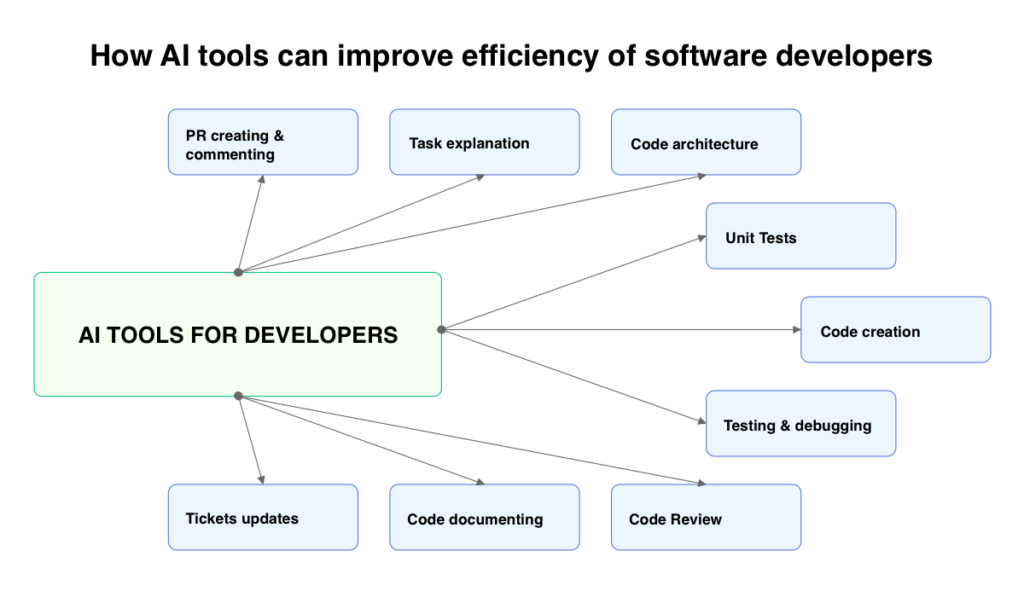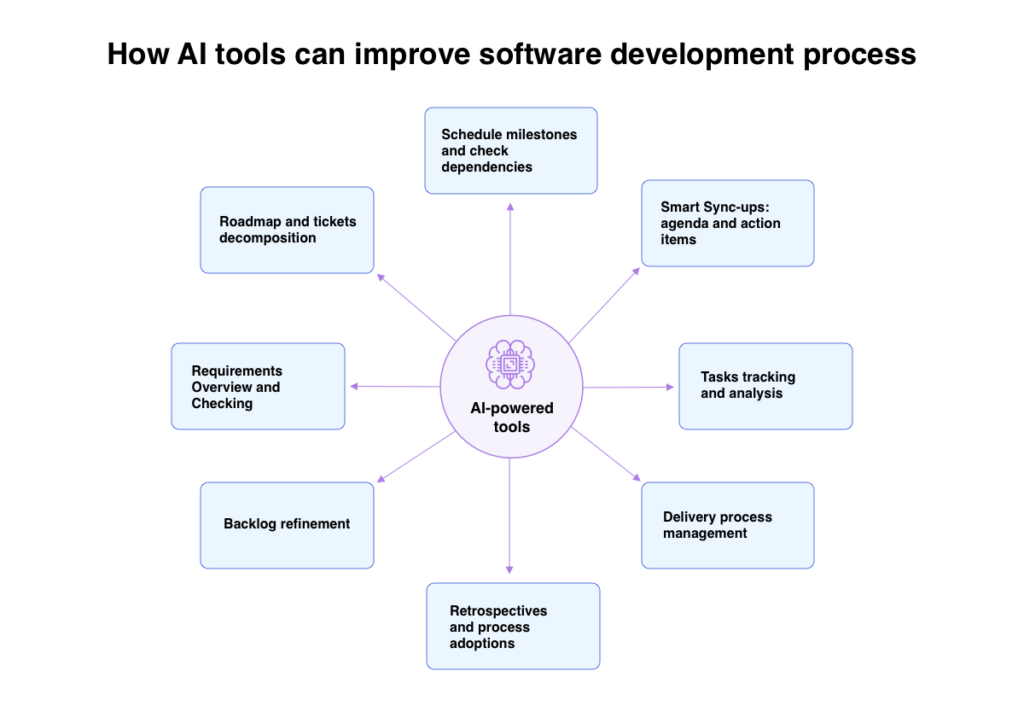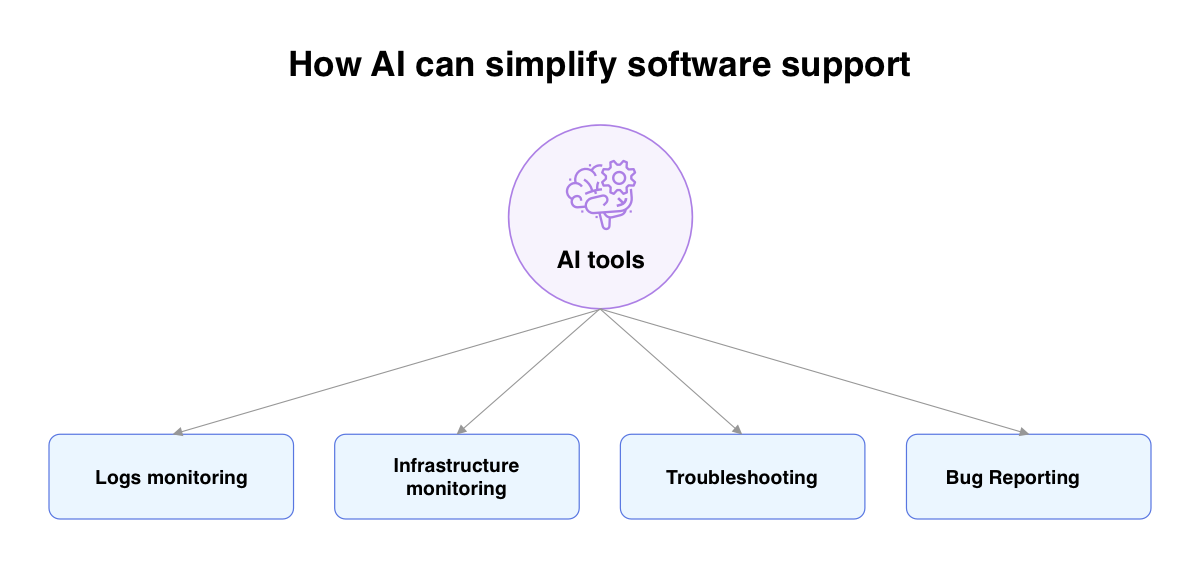-
Contents
- Introduction
- Traditional Software Development Cycle vs. AI-Powered Software Development Cycle
- Using AI to Improve the Management of Software Development Process
- AI-Enhanced Project Planning
- AI-Driven Communication and Collaboration
- Leveraging AI for Streamlining Routine Tasks
- Using AI-Powered Software Development to Simplify Support
- AI-Powered Software Development in Enhancing Troubleshooting and Bug Management
- How External Expertise in Generative AI Boosts the Project Outcomes

Introduction
AI-powered software development has revolutionized the tech industry, transforming how projects are conceived, executed, and managed. By integrating AI into the software development lifecycle, companies can automate complex tasks, enhance decision-making, and boost overall efficiency. The McKinsey study reveals that organizations leveraging AI in their processes can experience up to a 40% increase in productivity, highlighting AI’s transformative potential in software development.
For organizations aiming to stay competitive in our increasingly digital world, understanding AI’s impact on project management is crucial. Traditional project management methods, while robust, often need help to keep up with the dynamic nature of modern software projects. AI introduces a new approach where data-driven insights, predictive analytics, and intelligent automation significantly improve project outcomes.
Traditional Software Development Cycle vs. AI-Powered Software Development Cycle
The Software Development Life Cycle (SDLC) has long been the foundation for creating reliable and functional software. However, the rise of AI has brought significant changes, reshaping how software is developed and managed. This section compares the traditional SDLC with the AI-powered software development cycle, highlighting key differences and transformations.

Traditional Software Development Cycle:
- Initiation. Project goals and feasibility are defined based on manual research and stakeholder input.
- Planning. Detailed project plans, including timelines, resource allocation, and budget, are created manually.
- Design. System architecture and design are developed by engineers and designers through iterative processes.
- Development. Code is written, reviewed, and integrated by developers using standard programming practices.
- Testing. Software is thoroughly tested for bugs and performance issues through manual and automated testing.
- Deployment. The final product is deployed to production environments, often involving manual intervention.
- Maintenance. Ongoing support and updates are provided to ensure software functionality and performance.
AI-Powered Software Development Cycle:
- Initiation. AI tools analyze market trends, customer feedback, and historical data to assess project feasibility and set goals.
- Planning. AI-driven project management tools optimize timelines, resource allocation, and budgets using predictive analytics.
- Design. AI assists in creating system architecture and design, offering automated prototyping and design validation.
- Development. AI algorithms generate code, detect bugs in real time, and suggest improvements, significantly speeding up development.
- Testing. AI automates extensive testing, including regression, performance, and security testing, ensuring higher accuracy and efficiency.
- Deployment. AI-enhanced continuous integration and deployment (CI/CD) pipelines streamline the deployment process with minimal manual intervention.
- Maintenance. Predictive maintenance and AI-driven support systems proactively identify and resolve issues, enhancing software reliability.
In summary, integrating AI into the software development cycle brings transformative changes that boost efficiency, accuracy, and overall project success. By understanding these differences, organizations can better leverage AI to optimize their development processes and achieve superior outcomes.
Using AI to Improve the Management of Software Development Process
Most project management professionals view AI positively, recognizing its potential to streamline scheduling, progress tracking, and team management. The AI in Project Management Survey reveals that 80% of companies rate their acceptance of AI as somewhat or extremely high, showing a readiness to embrace AI despite its perceived novelty.
Companies that have adopted AI report improved efficiency, time savings, and better project outcomes. High satisfaction levels (44% extremely satisfied, 46% very satisfied) among these companies indicate AI’s tangible value and support for decision-making processes.
Key Applications of AI in Project Management for 2024
- Risk Anticipation. AI examines past data to foresee risks and propose mitigation plans, enabling PMs to tackle potential problems proactively.
- Workflow Automation. AI manages routine tasks like progress updates and report creation, freeing PMs to concentrate on high-impact activities.
- Forecasting Analytics. AI projects possible schedules and budget excesses, supporting precise planning and resource distribution.
A significant 88% of project managers express confidence in assigning tasks to AI, promoting further investment in AI technology to enhance workflow automation, forecasting analytics, and project planning.
AI-Enhanced Project Planning
AI-enhanced project planning is transforming the way software development projects are structured, implemented, and delivered. Let’s explore how AI is reshaping project planning through automated schedule creation, resource management, and predictive analytics for forecasting.
Automated Project Schedule Generation
A major benefit of AI in project planning is its capacity to automate project schedule creation. Traditional approaches often depend on manual input, which can be time-intensive and error-prone. AI algorithms, however, can scrutinize historical project data, evaluate task dependencies, and produce accurate timelines much faster.
For example, industry leaders like Microsoft and Asana are incorporating AI into their project management solutions to automate schedule creation. These AI systems factor in various elements, such as task duration, resource availability, and potential bottlenecks, to generate realistic and optimized project timelines. A McKinsey study reveals that companies utilizing AI for project planning have witnessed up to a 20% boost in project delivery speed.
Predictive Analytics for Project Forecasting
Predictive analytics is another powerful application of AI in project planning. By analyzing historical data and current project parameters, AI can forecast potential outcomes, identify risks, and suggest proactive measures. This capability allows project managers to make informed decisions and adjust plans dynamically.
Gartner’s research indicates that predictive analytics can improve project success rates by up to 30%. AI tools like Oracle’s Primavera P6 and Smartsheet leverage predictive analytics to offer real-time insights into project performance, helping managers anticipate issues before they escalate.
A case study involving AI in project management at a leading construction firm demonstrated a 25% reduction in project delays. The firm used AI to predict potential risks and took preventive actions, such as reallocating resources and adjusting timelines, based on the AI’s recommendations.
AI-Driven Communication and Collaboration
Effective communication and collaboration are vital to the success of AI-powered software development projects. AI-powered tools are revolutionizing these areas by automating routine tasks, facilitating seamless interactions, and providing intelligent support to team members. Here’s how AI is enhancing communication and collaboration in software development.
AI-Enhanced Communication Tools
AI-enhanced communication tools significantly improve team interactions and information sharing. These tools use natural language processing (NLP) to understand and respond to queries, automate routine communications, and provide real-time translation services. By reducing time spent on mundane tasks, AI-powered communication tools allow team members to focus on more strategic and creative aspects of their work.
For instance, Slack integrates AI to streamline team communication. AI bots in Slack can automate notifications, summarize conversations, and even provide insights based on message analytics. A Deloitte study reports that companies using AI-powered communication tools have seen a 15% increase in team productivity and a 25% reduction in miscommunication.
AI Assistants for Meeting Coordination and Follow-Ups
AI assistants are becoming essential in managing meeting schedules and follow-ups. These AI-driven tools can handle various administrative tasks, such as scheduling meetings, sending reminders, and summarizing meeting notes, thus freeing up valuable time for team members.
AI assistants like Microsoft’s Cortana and Google Assistant revolutionize meeting management in software development. These tools sync with calendars, find optimal meeting times, and send invites automatically. AI also tracks action items and sends reminders, ensuring timely task completion.
Clara, an AI assistant, exemplifies this technology by handling scheduling and follow-ups via email. It processes natural language requests, coordinates with multiple participants, and efficiently organizes meetings. A survey by AI Multiple reveals that companies using AI virtual assistants for scheduling have cut administrative task time by 30%.
AI-Based Collaboration Platforms
AI-powered collaboration platforms boost teamwork in software development by offering smart support and insights. These platforms recommend relevant documents, suggest potential collaborators, and predict project hurdles based on team dynamics and project data.
Trello and Asana incorporate AI to enhance collaboration. Trello uses AI to suggest task priorities and streamline workflows, while Asana employs machine learning to provide project insights and optimize task assignments.
IBM’s Watson AI in collaboration tools stands out. It analyzes team interactions, suggests ways to improve collaboration, and identifies potential communication issues. This has led to a 20% increase in project completion rates and a more unified team environment in AI-powered software development projects.
Leveraging AI for Streamlining Routine Tasks
AI-driven automation enhances efficiency and enables project managers and developers to concentrate on more strategic and intricate activities. Let’s explore how AI is revolutionizing task allocation and monitoring, progress reporting, and risk assessment and management.
Task Allocation and Monitoring
AI can optimize task assignments by evaluating team members’ capabilities, current workloads, and previous accomplishments to distribute tasks effectively. This ensures the most suitable individuals are assigned to each task, maximizing productivity and reducing bottlenecks.
Platforms such as Jira and Monday.com utilize AI algorithms to suggest task assignments based on various factors, including team members’ expertise, availability, and project needs. These tools can also automatically track task progress, providing real-time updates and notifications if deadlines are at risk.
Research by McKinsey revealed that companies implementing AI for task allocation and monitoring experienced a 15% improvement in task completion times and a 20% decrease in project management overhead. By automating these routine tasks, AI allows project managers to focus on high-level planning and decision-making.
Progress Reporting and Status Updates
Progress reporting is crucial for keeping stakeholders informed about project status. AI can automate the creation of status reports, ensuring they are precise, timely, and based on up-to-date information.
AI-powered project management tools can gather data from various sources, analyze it, and generate comprehensive reports highlighting key metrics, achieved milestones, and any deviations from the plan. These tools can also provide visual dashboards offering a quick overview of project health.
For example, Wrike and Asana use AI to automate status reporting and progress updates. These platforms extract data from ongoing tasks and generate detailed reports that can be tailored to different stakeholders’ needs. A PwC survey found that companies using AI for status reporting saw a 25% increase in reporting accuracy and a 30% reduction in report preparation time.
Risk Assessment and Management
AI excels at identifying potential risks in software development projects by analyzing vast amounts of data and detecting patterns that may indicate issues. AI can predict risks related to timelines, resource constraints, and technical challenges, enabling proactive mitigation strategies.
For instance, Microsoft Project and Oracle Primavera incorporate AI to continuously monitor project data and flag potential risks. These tools use predictive analytics to assess the likelihood of risks and suggest mitigation actions, such as reallocating resources or adjusting project schedules.
An IBM case study showed that using AI for risk management reduced project delays by 30% and cost overruns by 20%. The AI systems were able to identify risks early and provide actionable insights, allowing project managers to address issues before they escalated.
Using AI-Powered Software Development to Simplify Support
AI is transforming software support by streamlining key processes such as log monitoring, infrastructure oversight, troubleshooting, and bug reporting. By harnessing AI, organizations can achieve greater efficiency, accuracy, and responsiveness in maintaining and improving their software systems.

Log Monitoring
Logs are vital for tracking application behavior, diagnosing issues, and ensuring security compliance. Traditional log monitoring can be time-consuming and error-prone. However, AI-powered log monitoring tools can process vast amounts of log data in real-time, identify patterns, and detect anomalies that might indicate potential issues.
Example: A major e-commerce platform implemented an AI-driven log monitoring solution that reduced their mean time to detection (MTTD) by 40%. The system identified subtle deviations in transaction logs that indicated a potential security breach, allowing the team to mitigate the risk promptly.
Infrastructure Oversight
Maintaining the health and performance of IT infrastructure is crucial for the smooth operation of software applications. AI-enhanced infrastructure monitoring tools continuously assess the state of servers, networks, and other components, providing insights into performance metrics and potential failures.
Example: Netflix uses its AI-powered monitoring system to manage its complex cloud infrastructure. The system analyzes terabytes of data daily, predicting server failures and automatically rerouting traffic to maintain a smooth viewing experience for millions of users worldwide.
AI-Powered Software Development in Enhancing Troubleshooting and Bug Management
Effective troubleshooting is crucial for minimizing downtime and user impact by quickly identifying the root cause of issues. AI-driven tools excel at this by analyzing data from various sources like logs, performance metrics, and user reports to accurately diagnose problems and suggest solutions.
Example: IBM’s Watson AIOps showcases AI’s power in IT operations automation. Using natural language processing, it analyzes incident reports and logs, providing actionable insights and recommended fixes. This approach has cut incident resolution time by up to 50%.
Streamlining Bug Reporting
Bug reporting is vital for efficient software support, ensuring issues are documented, prioritized, and resolved effectively. AI-powered tools automate the capture of relevant information, such as system states and user actions leading to an issue, reducing manual reporting needs. These tools also prioritize bugs based on impact and suggest fixes by analyzing past resolutions.
Example: Microsoft’s Visual Studio IntelliCode uses AI to assist developers in recommending code changes and spotting potential bugs. By learning from the codebase and past bug reports, it helps catch issues early, improving code quality and reducing debugging time.
How External Expertise in Generative AI Boosts the Project Outcomes
The integration of AI into the software development lifecycle is now a reality, driving significant improvements in efficiency, accuracy, and project success. AI-powered software development tools are transforming every stage of development, from planning to maintenance, helping organizations stay competitive in the digital landscape.
While off-the-shelf AI solutions offer benefits, custom AI tools tailored to specific organizational needs can provide a competitive edge. This is where external expertise in generative AI becomes crucial.
Engaging external AI experts like Processica can help organizations:
Create Bespoke Solutions
Custom AI tools can address unique challenges that generic solutions may miss. External experts can design AI models aligned with specific business goals and technical environments.
Speed Up Development
Tailored AI tools can accelerate various development stages, from code generation to predictive maintenance, reducing time-to-market and enhancing product quality.
Optimize Process Management
AI-driven project management tools offer predictive analytics, risk management, and resource optimization. External expertise ensures seamless integration with existing processes, maximizing impact.
Enhance Decision-Making
AI provides data-driven insights that improve decision-making throughout the development process. Experts can help organizations effectively use these insights for informed, timely decisions aligned with strategic objectives.
In conclusion, while AI offers immense potential to revolutionize software development and project management, leveraging external expertise in generative AI can amplify these benefits. Partner with Processica, an expert team in custom AI-powered software development solutions, to create custom tools tailored to your needs. Our experts will help you harness AI’s full potential, accelerate development cycles, and achieve superior project outcomes.
Contact Processica today to start your journey towards more efficient, innovative, and successful software development.


